APOBEC family reshapes the immune microenvironment and therapy sensitivity in clear cell renal cell carcinoma
- PMID: 39249558
- PMCID: PMC11383847
- DOI: 10.1007/s10238-024-01465-2
APOBEC family reshapes the immune microenvironment and therapy sensitivity in clear cell renal cell carcinoma
Abstract
Emerging evidence suggests that the APOBEC family is implicated in multiple cancers and might be utilized as a new target for cancer detection and treatment. However, the dysregulation and clinical implication of the APOBEC family in clear cell renal cell cancer (ccRCC) remain elusive. TCGA multiomics data facilitated a comprehensive exploration of the APOBEC family across cancers, including ccRCC. Remodeling analysis classified ccRCC patients into two distinct subgroups: APOBEC family pattern cancer subtype 1 (APCS1) and subtype 2 (APCS2). The study investigated differences in clinical parameters, tumor immune microenvironment, therapeutic responsiveness, and genomic mutation landscapes between these subtypes. An APOBEC family-related risk model was developed and validated for predicting ccRCC patient prognosis, demonstrating good sensitivity and specificity. Finally, the overview of APOBEC3B function was investigated in multiple cancers and verified in clinical samples. APCS1 and APCS2 demonstrated considerably distinct clinical features and biological processes in ccRCC. APCS1, an aggressive subtype, has advanced clinical stage and a poor prognosis. APCS1 exhibited an oncogenic and metabolically active phenotype. APCS1 also exhibited a greater tumor mutation load and immunocompromised condition, resulting in immunological dysfunction and immune checkpoint treatment resistance. The genomic copy number variation of APCS1, including arm gain and loss, was much more than that of APCS2, which may help explain the tired immune system. Furthermore, the two subtypes have distinct drug sensitivity patterns in clinical specimens and matching cell lines. Finally, we developed a predictive risk model based on subtype biomarkers that performed well for ccRCC patients and validated the clinical impact of APOBEC3B. Aberrant APOBEC family expression patterns might modify the tumor immune microenvironment by increasing the genome mutation frequency, thus inducing an immune-exhausted phenotype. APOBEC family-based molecular subtypes could strengthen the understanding of ccRCC characterization and guide clinical treatment. Targeting APOBEC3B may be regarded as a new therapeutic target for ccRCC.
Keywords: APOBEC family; Clear cell renal cell carcinoma; Machine learning; Molecular subtypes; Multiomics; Tumor immunity.
© 2024. The Author(s).
Conflict of interest statement
The authors declare no competing interests.
Figures
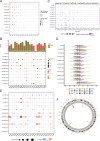
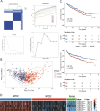
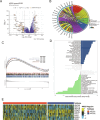
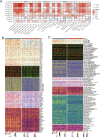
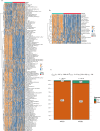
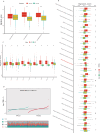
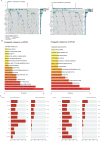
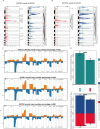

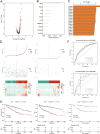
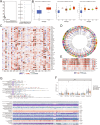
Similar articles
-
SPCS, a Novel Classifier System Based on Senescence Axis Regulators Reveals Tumor Microenvironment Heterogeneity and Guides Frontline Therapy for Clear Cell Renal Carcinoma.Clin Genitourin Cancer. 2024 Apr;22(2):497-513. doi: 10.1016/j.clgc.2024.01.005. Epub 2024 Jan 12. Clin Genitourin Cancer. 2024. PMID: 38245436
-
Integrated Multi-Omics Analysis Unveils Distinct Molecular Subtypes and a Robust Immune-Metabolic Prognostic Model in Clear Cell Renal Cell Carcinoma.Int J Mol Sci. 2025 Mar 28;26(7):3125. doi: 10.3390/ijms26073125. Int J Mol Sci. 2025. PMID: 40243888 Free PMC article.
-
TUBA1C orchestrates the immunosuppressive tumor microenvironment and resistance to immune checkpoint blockade in clear cell renal cell carcinoma.Front Immunol. 2024 Sep 5;15:1457691. doi: 10.3389/fimmu.2024.1457691. eCollection 2024. Front Immunol. 2024. PMID: 39301023 Free PMC article.
-
Roles of the Dynamic Tumor Immune Microenvironment in the Individualized Treatment of Advanced Clear Cell Renal Cell Carcinoma.Front Immunol. 2021 Mar 4;12:653358. doi: 10.3389/fimmu.2021.653358. eCollection 2021. Front Immunol. 2021. PMID: 33746989 Free PMC article. Review.
-
Clear cell renal cell carcinoma ontogeny and mechanisms of lethality.Nat Rev Nephrol. 2021 Apr;17(4):245-261. doi: 10.1038/s41581-020-00359-2. Epub 2020 Nov 3. Nat Rev Nephrol. 2021. PMID: 33144689 Free PMC article. Review.
Cited by
-
Ligand-receptor interactions combined with histopathology for improved prognostic modeling in HPV-negative head and neck squamous cell carcinoma.NPJ Precis Oncol. 2025 Feb 28;9(1):57. doi: 10.1038/s41698-025-00844-6. NPJ Precis Oncol. 2025. PMID: 40021759 Free PMC article.
References
MeSH terms
Substances
Grants and funding
- 81902560,81730073, 81872074/The National Natural Science Foundation of China
- 81902560,81730073, 81872074/The National Natural Science Foundation of China
- 81902560,81730073, 81872074/The National Natural Science Foundation of China
- 81902560,81730073, 81872074/The National Natural Science Foundation of China
- 2018YFA0108300/The China National Key Research and Development Program Stem Cell and Translational Research Key Projects
- 2018YFA0108300/The China National Key Research and Development Program Stem Cell and Translational Research Key Projects
- 2018YFA0108300/The China National Key Research and Development Program Stem Cell and Translational Research Key Projects
- 2018YFA0108300/The China National Key Research and Development Program Stem Cell and Translational Research Key Projects
LinkOut - more resources
Full Text Sources
Medical

